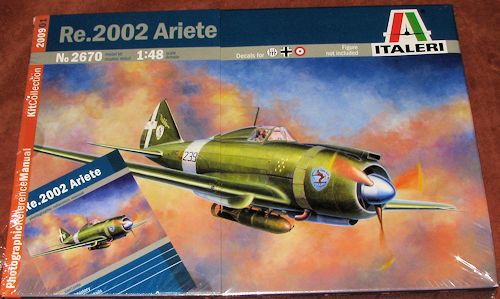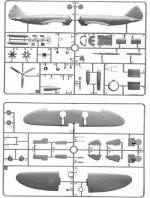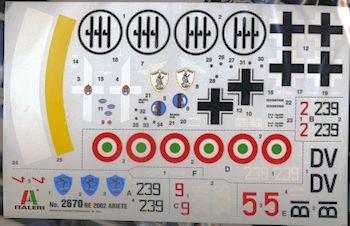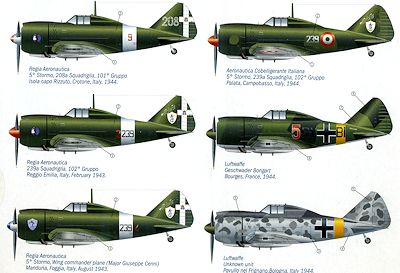
Italeri 1/48 Reggiane Re.2002
| KIT #: | 2670 |
| PRICE: | $54.00 SRP |
| DECALS: | Six options |
| REVIEWER: | Scott Van Aken |
| NOTES: |

| HISTORY |
The Re.2002 project began with the conversion of the Re.2000 to Regia Aeronautica specifications including a redesigned wing and conventional fuel tanks. A contract for a single conversion resulted in the Reggiane company using this as the basis of a new aircraft. The Re.2002 was designed by Roberto Longhi and Antonio Alessio, who took a modified and strengthened Re.2000 fuselage, mated to Re.2001 wings and a more powerful radial engine, the Piaggio P.XIX R.C.45 Turbine (1,175 hp). The decision to go back to radial engines was partly made due to the difficulty in obtaining German made Daimler-Benz DB 601 engines and Longhi's preference for radial engines.
The first prototype flew in October 1940, approximately three months after the Re.2001. The evaluation period showed some reliability problems with the Piaggio engine and therefore the aircraft served primarily as an attack aircraft instead, as it could carry a considerable payload, by Italian standards. 18 examples of a dive bomber version were made.
In September 1941, the Italian Air Force ordered 200 aircraft, delivery of which began in March 1942. The aircraft equipped the 5° Stormo and 50° Stormo, although the engine problems hadn't been fully solved. The first batch of 100 aircraft were delivered by July 1943, but only part of the second batch was delivered before the armistice with the Allies.
The squadrons equipped with Re.2002s saw a great deal of action with the Allied landings in Sicily although they also suffered many losses. During the first four days, when the Italian Air Force tried to attack allied ships, 14 aircraft were destroyed by British Spitfire Mk Vs. Allied bombing raids and strafing of airfields destroyed many aircraft on the ground. Due to the lack of fuel, the Re.2002s were only used sporadically, often equipped with three 250 kg or 100 kg bombs.
Some of the last skirmishes took place on September 3, 1943, when the British 8th Army landed at Calabria. Fifteen Re.2002s from 5° Stormo attacked the landing force. Three pilots were killed; among them was Giuseppe Cenni, the commander of the unit.
The Germans had shown interest in buying 300 Re.2002s before the Armistice. They planned to use the German produced BMW 801 radial engine in order to eliminate the deficiencies with the Piaggio engine. However, Reggiane could not satisfy the demand, and none were delivered. However, some 40 "factory-fresh" Re.2002s along with 20 aircraft requisitioned from operational stocks were taken over by the Germans after the Italian armistice, and used against the French resistance.
| THE KIT |
 This
kit was heavily panned by reviewers; everything from fit issues to 'major' shape
problems. Well, for what ever reason, I did not pick it up when it was initially
issued in 2009, but when I found it on deep discount, I decided to go ahead and
get one. This is the 'PRM' (photographic reference manual) kit that comes with a
nice booklet that shows images from the tech manual as well as some pictures of
an aircraft undergoing restoration. It also has some color profiles which are
the same as the markings options provided in the kit.
This
kit was heavily panned by reviewers; everything from fit issues to 'major' shape
problems. Well, for what ever reason, I did not pick it up when it was initially
issued in 2009, but when I found it on deep discount, I decided to go ahead and
get one. This is the 'PRM' (photographic reference manual) kit that comes with a
nice booklet that shows images from the tech manual as well as some pictures of
an aircraft undergoing restoration. It also has some color profiles which are
the same as the markings options provided in the kit.
The kit itself is on two grey and one clear sprue. The clear one is for the canopy, windscreen and gun sight and is not shown in the parts diagram. The surface detailing is fairly good and up to modern standards, though not exceptional. This is a pretty simple aircraft in terms of construction.
The cockpit is well done, looking like a modern Hasegawa kit in terms of having a floor, instrument panel, side walls, seat and rear framework. The seat has a harness molded on it. The kit instructions would have you open up two rectangular sections in the side of the fuselage in order to install a small box structure. Separate doors are provided for these. I have no idea what these are for and they seem like 'make do' work. When I build mine I'll leave them alone.
Main landing gear bays are separate and lack any detail, but this may well be prototypical. There is a separate bulkhead on which the tail gear is attached. This will need to be installed prior to closing the fuselage halves. There are separate elevators though they can only be built in the neutral position thanks to the squared ends. Separate flaps are also provided, these being split. A fair engine representation is provided with two separate rows that are mated together. A push rod ring is included as well as a prop dome. The cowling is in three pieces with two sides and a full forward section so no lip seams. For things under wings you have a single rack and can either hook it up as a dive bomber assembly with the crutch or as a simple gravity bomb rack. A fuel tank is also available to install. There is a separate canopy section so you can pose it open if you so wish.
Instructions are of the photo variety instead of line
drawings and it seems quite acceptable. Decals are provided for six different
aircraft. Four of them are in the standard scheme of dark green ove r
light grey. Three of these planes are with the Reggia Aeronautica. Two are with
the 239a Squadriglia with the white bands on the fuselage. Another is with 208a
Squadriglia and while listed as being from 1944, this date is clearly in error
as none of these planes wore the old R.A. markings after the armistice. One
option is for a plane with the 23
r
light grey. Three of these planes are with the Reggia Aeronautica. Two are with
the 239a Squadriglia with the white bands on the fuselage. Another is with 208a
Squadriglia and while listed as being from 1944, this date is clearly in error
as none of these planes wore the old R.A. markings after the armistice. One
option is for a plane with the 23 9a
Squadriglia when with the Co-belligerant air force fighting on the side of the
allies. Two are in German markings. One is with Geschwader Bongart fighting
against paristans in France and has a yellow fusleage band with the camo in RLM
70/71/65 as befits a bomber type. The other is in RLM 74/75/76 and attached to
an unknown unit in Northern Italy in 1944. It also wears a yellow fuselage band.
The decal sheet is very nicely done so whichever option you choose will turn out
well. I have darkened the scan of the decals to allow the white to show up
better.
9a
Squadriglia when with the Co-belligerant air force fighting on the side of the
allies. Two are in German markings. One is with Geschwader Bongart fighting
against paristans in France and has a yellow fusleage band with the camo in RLM
70/71/65 as befits a bomber type. The other is in RLM 74/75/76 and attached to
an unknown unit in Northern Italy in 1944. It also wears a yellow fuselage band.
The decal sheet is very nicely done so whichever option you choose will turn out
well. I have darkened the scan of the decals to allow the white to show up
better.
| CONCLUSIONS |
Italian fighters in this scale beyond the usual Macchis and Fiats are not very common. C.A. did a whole bunch of Reggiane aircraft and with this one from Italeri, we now have another. To be honest with you, the book is not an incentive to me to buy this kit. The fact that it was on deep discount was what drew me to it. I can see why it was on sale as, in my opinion, you really do not get your money's worth at SRP. Still, it will build into a very nice model with a bit of work and those of you who like Italian aircraft in this scale should look for it again when it goes on sale.
| REFERENCES |
http://en.wikipedia.org/wiki/Reggiane_Re.2002
September 2013 Thanks to me for picking this one up when it was on sale. If you would like your product reviewed fairly and fairly quickly, please contact the editor or see other details in the
Note to
Contributors.